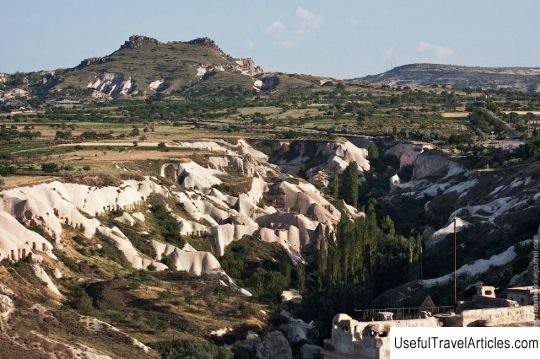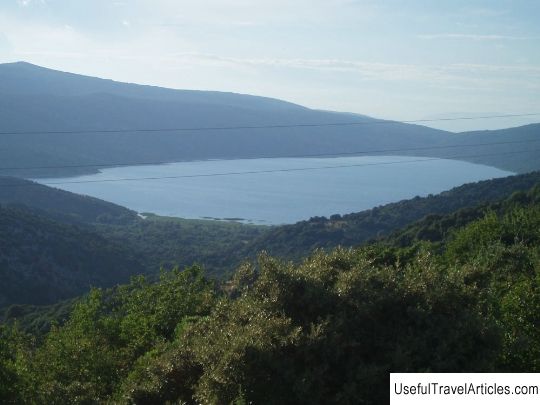Soganli Valley (Soganli) description and photos - Turkey: Cappadocia
Rating: 7,9/10 (800 votes) 
Soganli Valley description and photos - Turkey: Cappadocia. Detailed information about the attraction. Description, photographs and a map showing the nearest significant objects. The name in English is Soganli. Photo and descriptionOne of the most breathtaking sights south of Yurgup is the Soganly valley, named after the village of the same name lying in its very center five kilometers west of the road from Yurgup to Yesilhisar. The Soganli Valley is located twenty-five kilometers from the underground city of Derinkuyu, where you can see an ensemble of tuff-carved structures similar to those located in Goreme - an open-air museum. Not far from the village, there is a place where local people bred pigeons. During the work to recreate the original appearance of the area, Christian churches were discovered, which lie on both banks of the stream. Even before the 13th century, starting from the early Byzantine period, the valley was inhabited. Soganli translated from Turkish means "with a bow", however, there is another hypothesis that the name of the valley comes from the phrase sona kaldi (remained until the end). This theory stems from the fact that Soganli was the last valley in Cappadocia, which the Arab invaders led by Batal Gazi reached in the 6th century. Now the valley is also located away from the main roads. It attracts travelers and tourists with its isolation from the rest of the world The village includes two settlements - the upper Yukary-Soganly and the lower Ashagy-Soganly. The village of Yukary-Soganly is located on a rocky promontory that divides the valley into two parts. A walking path that crosses the stream originates from the local square and leads up the hillside through the entire village. Walking along this path you can come to the Hidden Church with frescoes depicting the apostles, and after another hundred meters come to Kubbeli Kilisa or the Church with a dome. This church consists of two parts, located on different floors. There are three portals at the entrance. Further, the church is divided by two rows of pylons and pilasters into three naves and is equipped with benches. In the depths of the central and side naves are vaulted side-chapels with altars. The upper floor has a more complex plan: two parallel long chapels are adjacent and are equipped with porches. A small apse with a narthex that covers the dome can be seen in the right chapel, while in the left chapel there is an altar. He stands right against the back wall. The square vestibule itself faces both chapels, the vestibule and the interior. It seems that this church was built inside a huge "fly agaric", and its "hat" became a dome. Of no less interest is the Serpent Church and its interior decoration, which can only be seen with the help of a flashlight. The most popular and famous religious story in Cappadocia is Saint George slaying the dragon. His image is located to the left of the entrance. It is also worth looking into the Church of the Black Head, on the walls of which frescoes with episodes from the life of Christ and the saints, various religious symbols, are preserved, but at the same time, some frescoes depict non-traditional subjects associated with ancient cults. Part of the building was destroyed and has not survived to this day. The church has rooms for worship, connected to each other. You should definitely visit the Church of the Predator, which got its name from the beast of prey depicted on the frescoes next to St. John. The church has two rooms: one contains an altar with burial niches in the walls; the second room has a square shape and is adjacent to the first. The Church of St. Barbara also consists of two adjacent churches. It collapsed badly, but it was found that the two parallel rooms were almost the same, but with different proportions. The image of St. Barbara, after whom the whole ensemble is named, was identified from the fragments of the frescoes. The temple dedicated to the Virgin Mary is located in the lowlands. Almost all the walls of the church are painted with frescoes. In some places, the lower layer is visible, on which more primitive images and not so colorful are applied. Yilanli Church is dedicated to St. George. Above the entrance there is an inscription saying that she is very many years old. Her frescoes contain a large number of images of St. John, The Twelve Apostles and other biblical scenes. On the walls of most temples, quite a lot of inscriptions were made, mainly in Greek, some of which date back to the 19th century. Not without vandalism: tourists, as well as the Turks themselves, painted all the walls with their names and forever destroyed part of the frescoes. The following temples are already at the top of the valley. The Blast Church is especially interesting. This is a full-fledged temple with columns on two floors. The lower floor is used for housekeeping, and the upper floor is used for the church. It is a labyrinth with a large number of abruptly falling steps, a couple of exits leading nowhere and small rooms. Some kind of anthill is created. There are also many underground graves here. The condition of the monastery is gradually deteriorating, in some places the floor is collapsing. There are practically no frescoes here,       We also recommend reading Hawa Mahal description and photos - India: Jaipur Topic: Soganli Valley (Soganli) description and photos - Turkey: Cappadocia. |




